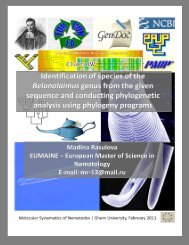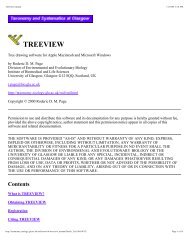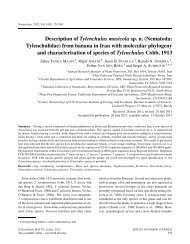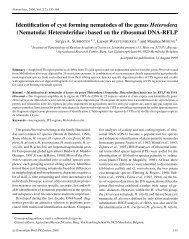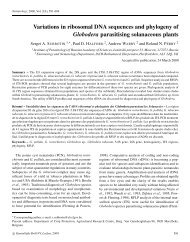Morphological and molecular characterisation of Californian species ...
Morphological and molecular characterisation of Californian species ...
Morphological and molecular characterisation of Californian species ...
You also want an ePaper? Increase the reach of your titles
YUMPU automatically turns print PDFs into web optimized ePapers that Google loves.
S. Álvarez-Ortega et al.<br />
DIAGNOSIS AND RELATIONSHIPS<br />
This <strong>species</strong> is characterised by its body 1.99-2.48 mm<br />
long, lip region <strong>of</strong>fset by deep constriction <strong>and</strong> 14-15 μm<br />
broad, odontostyle 13-15 μm long with its aperture occupying<br />
67-75% <strong>of</strong> its length, neck 456-529 μm long, pharyngeal<br />
expansion 216-276 μm long or 47-50% <strong>of</strong> total<br />
neck length, pharyngo-intestinal junction bearing a dorsal<br />
lobe, female genital system didelphic-amphidelphic,<br />
uterus tripartite <strong>and</strong> 201-262 μm long or 3.7-4.7 times<br />
corresponding body diam., pars refringens vaginae with<br />
two well developed sclerotised pieces, vulva transverse<br />
(V = 55-58), tail conical (43-55 μm, c = 43-52, c ′ =<br />
1.3-1.6) with its inner core somewhat notched <strong>and</strong> nearly<br />
reaching the tip, spicules 54-63 μm long, <strong>and</strong> 6-7 spaced<br />
ventromedian supplements located outside the range <strong>of</strong><br />
the spicules.<br />
The new <strong>species</strong> is very similar to M. mombucae<br />
Lordello, 1965, a poorly known <strong>species</strong> since the original<br />
description by Lordello (1965; see also 1967), on<br />
the basis <strong>of</strong> a single Brazilian female, lacks relevant details<br />
such as the morphology <strong>of</strong> the genital system (presence/absence<br />
<strong>of</strong> pars refringens vaginae, uterus length,<br />
etc.) <strong>and</strong> <strong>of</strong> the inner core <strong>of</strong> the tail. The description <strong>of</strong> the<br />
<strong>Californian</strong> specimens in general fits well with the original<br />
one, although the lip region is narrower (vs 18.5 μm),<br />
the odontostyle shorter (vs 16.8 μm) <strong>and</strong> the tail is relatively<br />
shorter (vs c = 34.2). Monteiro (1970a, b) studied<br />
a Brazilian population (six females <strong>and</strong> seven males) that<br />
the author identified as A. conicaudatus (Altherr, 1953)<br />
Monteiro, 1970 but that Andrássy (2001) regarded as<br />
identical to A. mombucae. Monteiro (1970) provided measurements<br />
<strong>of</strong> both sexes but, unfortunately, only described<br />
the male. The morphometrics <strong>of</strong> the females are also similar<br />
to those <strong>of</strong> the <strong>Californian</strong> specimens herein examined,<br />
although some differences are also noted, for instance<br />
longer odontostyle (15.7-18.6 μm), more anterior vulva<br />
(V = 50.5-54.6) <strong>and</strong> longer female tail (c = 30.2-35.7).<br />
Concerning the Brazilian males, they have longer (71.4-<br />
78.6 μm), more slender <strong>and</strong> less curved, ventrad spicules<br />
(see Monteiro, Fig. 5). Assuming that Lordello’s female<br />
<strong>and</strong> Monteiro’s population belong to the same <strong>species</strong>, the<br />
new <strong>species</strong> differs from them in having a shorter female<br />
tail, slightly more posterior vulva <strong>and</strong> shorter <strong>and</strong> more<br />
robust spicules. These differences might be interpreted<br />
as intraspecific variability but the morphology <strong>of</strong> spicules<br />
is an especially relevant character that provisionally supports<br />
the separation <strong>of</strong> the <strong>Californian</strong> material from the<br />
Brazilian.<br />
Andrássy (2001) proposed Aporcelaimellus indicus<br />
Baqri & Jairajpuri, 1968 as a junior synonym <strong>of</strong> M.<br />
mombucae, a questionable opinion since A. indicus can be<br />
distinguished from M. mombucae by having larger (L =<br />
2.40-2.45 vs 1.87-2.34 mm) <strong>and</strong> more slender body (a =<br />
49-50 vs 27.8-40.5), more posterior vulva (V = 57-58<br />
vs 50.5-55.7), shorter female tail (c = 41-43 vs 30.2-<br />
35.7) <strong>and</strong> male unknown (vs known). The <strong>Californian</strong><br />
specimens differ from A. indicus in the less slender<br />
body (a = 39-43 vs 49-50), shorter pharyngeal expansion<br />
(47-50 vs 56-57% <strong>of</strong> total neck length), pars refringens<br />
vaginae present (vs probably absent), shorter female tail<br />
(43-55 vs 56-60 μm, c ′ = 1.3-1.6 vs 1.8), <strong>and</strong> male present<br />
(vs unknown).<br />
MOLECULAR CHARACTERISATION<br />
One sequence <strong>of</strong> D2-D3 <strong>of</strong> 28S rDNA gene in length <strong>of</strong><br />
768 bp was obtained.<br />
Metaporcelaimus ovogranulosus * sp. n.<br />
(Figs 4, 5)<br />
MATERIAL EXAMINED<br />
Nineteen females from one location in good state <strong>of</strong><br />
preservation.<br />
MEASUREMENTS<br />
See Table 2.<br />
DESCRIPTION<br />
Female<br />
Slender nematodes <strong>of</strong> medium size, 1.54-1.96 mm long.<br />
Body cylindrical, tapering towards both extremities, but<br />
more so towards posterior end as tail is conical. Habitus<br />
curved ventrad after fixation, especially in posterior<br />
body region, C-shaped. Cuticle 2.0-2.5 μm thick in anterior<br />
region, 2.5-3.5 μm at mid-body <strong>and</strong> 3.0-4.5 μm<br />
on tail, typical <strong>of</strong> genus, outer layer thin <strong>and</strong> bearing<br />
fine but distinct transverse striation throughout body, inner<br />
layer thicker than outer. Cervical lacunae may be<br />
present, but <strong>of</strong> variable development. Lateral chords 6-<br />
13 μm wide or 15-24% <strong>of</strong> mid-body diam., gl<strong>and</strong> bodies<br />
* The specific epithet refers to the morphology <strong>of</strong> the uterine egg<br />
shell.<br />
8 Nematology



